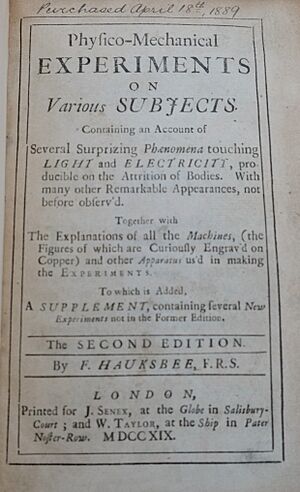Francis Hauksbee facts for kids
Francis Hauksbee the Elder (1660–1713) was an English scientist. He is famous for his work with electricity. He also studied how electric charges push or pull each other. People sometimes called him Francis Hawksbee.
Contents
Who Was Francis Hauksbee?
Francis Hauksbee was born in Colchester, England, in 1660. His father was a draper, which means he sold cloth. Francis was the fifth of five sons.
He went to Colchester Royal Grammar School in 1673. Later, he trained to be a draper like his father. He worked as a draper in London until about 1703.
Around 1701, he started making scientific tools. He made things like air-pumps. It's not fully clear how he switched from selling cloth to science.
Working with Isaac Newton
Francis Hauksbee became a helper for the famous scientist Isaac Newton. Newton was the president of the Royal Society. This was a group of important scientists.
Hauksbee joined the Royal Society in 1703. He showed them his new air-pump. He also showed them a strange glowing effect from mercury. Newton wanted more experiments at their meetings. Hauksbee became the main experimenter for the Royal Society. He showed new things almost every week.
He became a full member of the Royal Society in 1705. He continued his work near Fleet Street in London. Francis Hauksbee died in 1713. Another scientist, John Theophilus Desaguliers, took his place.
Hauksbee's Scientific Discoveries
Hauksbee was very good at making scientific tools. He was also great at doing experiments. He found many new and unexpected things. His most important work was about electricity. He studied how electric objects attract and repel each other.
Experiments with Light and Vacuum
Before 1705, Hauksbee mostly did experiments with air-pumps. Then, he started looking at how mercury glows. Mercury was known to glow in a vacuum, like inside a barometer.
He was the first person to realize that glass could be used for electrical experiments. This was a big step forward.
Creating an Electric Glow
Around 1705, Hauksbee made an amazing discovery. He used a glass ball, like a globe. He put a little mercury inside it. Then, he removed most of the air to create a small vacuum.
When he rubbed the glass ball, it built up an electric charge. If he put his hand on the outside of the ball, it would glow! This glow was bright enough to read by. It looked a bit like St. Elmo's fire. This discovery was very new and exciting.
This glowing effect later led to modern lights. It helped create gas-discharge lamps, like neon lighting and mercury vapor lamps. In 1706, he made a special machine to create this glow. He kept doing many experiments with electricity. He made machines to show different electrical effects.
Understanding Gases
In 1708, Hauksbee also discovered something important about gases. He found what is now called Charles's law. This law says that if you keep the pressure of a gas the same, its volume changes with its temperature. For example, if you heat a gas, it will take up more space.
Hauksbee Awards
The Royal Society created the Hauksbee Awards in 2010. These awards honor "unsung heroes" in science and technology. These are people whose important work might not get much recognition.
The awards became an annual event starting in 2022. They are given to individuals or teams. They celebrate people who support scientific work behind the scenes.
See also
 In Spanish: Francis Hauksbee para niños
In Spanish: Francis Hauksbee para niños


